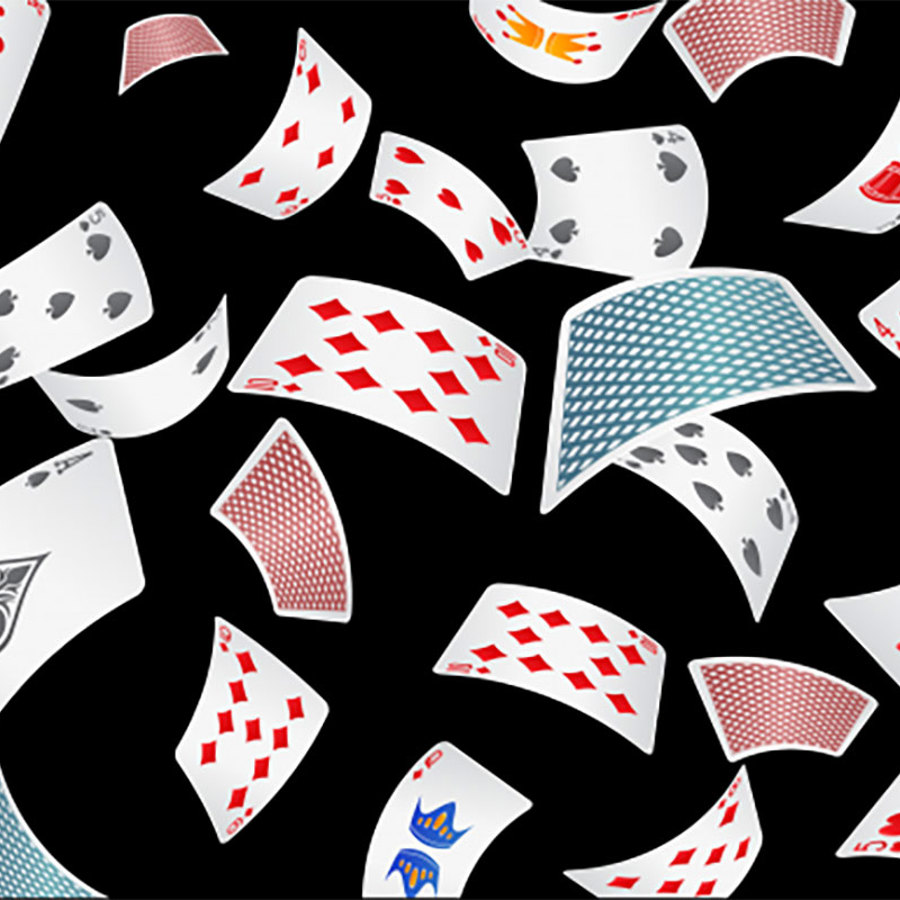
Why do half-siblings share 25% of their genes?
September 5, 2013

- Related Topics:
- Relatedness,
- Genomics,
- Consumer genetic testing,
- Editor's choice
A curious adult from Peru asks:
“Can you please explain why half-siblings share 25% of their genes? If 50% comes from each parent, then they should, in theory have 50% from the common parent. I know this is not so, but I do not know why.”
These percentage things are always tricky. While we do get 50% of our DNA from each parent, we don’t get the same 50% as our siblings.
In general, there is about a 50% overlap between the DNA you got from your mom and the DNA your brother or sister got from that same mom. So you and your sibling share 50% of 50% of mom’s DNA or 25%.
I always find this kind of explanation to be a bit confusing. An easier way to see what is going on is to do a simple experiment with a deck of cards.
Cards Are Like Genes …
Imagine that a standard deck of cards is the shared parent’s DNA. So I don’t have to keep saying shared parent, I’ll say it is mom’s DNA. Keep in mind, though, that this works for dad too!
You can do this experiment with a real deck of cards or with a random card generator like this one. For this answer, I’ll use the random generator.
First shuffle mom’s DNA and deal out 26 cards. These 26 cards represent the DNA you got from your mom. It is half of her DNA.
Here is my first set of cards from the random card generator:
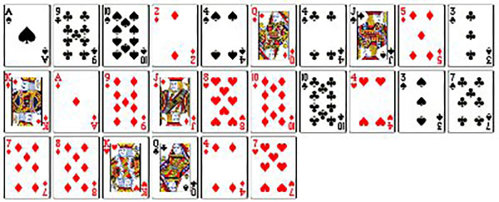
Next you add the cards back into the deck and “reshuffle” to get your sibling’s DNA. Here is what I got on my second deal:
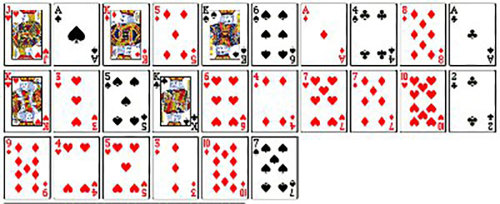
The first thing to notice is that the cards are not all the same. Even though you and your sibling each got 26 out of mom’s 52 cards, you didn’t get the same 26. You each got half the deck of cards but not the exact same half. Hopefully this helps explain why the two of you don’t share the same 50% of mom’s DNA.
Now let’s see how many cards the two of you share in common:
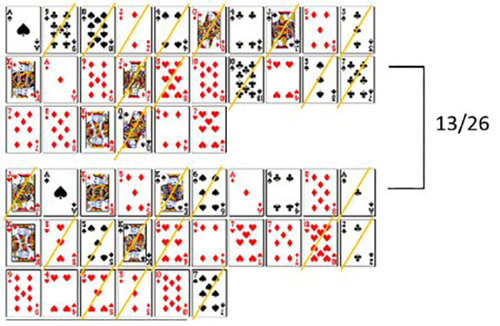
What I’ve done is put little yellow lines through the cards that don’t match. As you can see, the two of you have 13 of these cards in common.
So in this case, the two of you share 13 out of 52 of mom’s cards. In other words, the two of you share 25% of your mom’s DNA. (Note that both are still 50% related to their mom.)
If we are dealing with a half-sibling, this is all the two of you would be related. You’d have different dads and they wouldn’t be related at all. In our analogy, one might have “DNA” from an UNO deck and the other a different card game like Sorry.
So the two of you would share 13 out of 26 from mom and 0 out of 26 from dad. As half-siblings, you would share 13/52 cards or 25%.
In some ways I got very lucky with that first couple of deals. Because the cards are chosen at random, there is no reason I had to get a 13 out of 26 match in this case. Theoretically there is even a chance that they could all match or that none of them might! Let’s see what happens when we are dealt a third hand of 26 (this would be a third sibling):
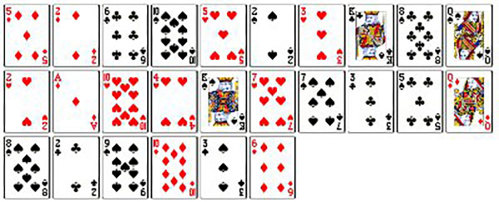
Again this sibling is 50% related to the shared mom … these 26 cards came from her deck of 52. But let’s line up all three and see how these three siblings match up:
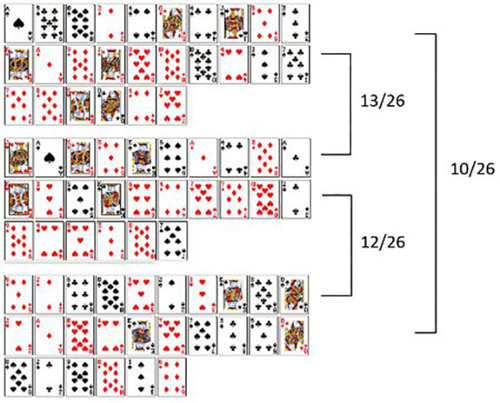
This time I didn’t put little lines through the cards that don’t line up so you’ll have to take my word for the numbers. (Or check to see if I’m right … I may have missed one!)
The first thing to notice is that we didn’t get a 13 out of 26 match each time. This is because the 26 that we get is random…as I said, it is theoretically possible to have none or all of them match. Here we got a 13/26, a 12/26, and even a 10/26. If this were exactly how DNA worked, in the last case the half-siblings would only share about 19% of their DNA.
Which can and does happen in real life! Here is a chart from ISOGG Wiki that gives you a feel for the kinds of ranges half siblings actually share in real life:
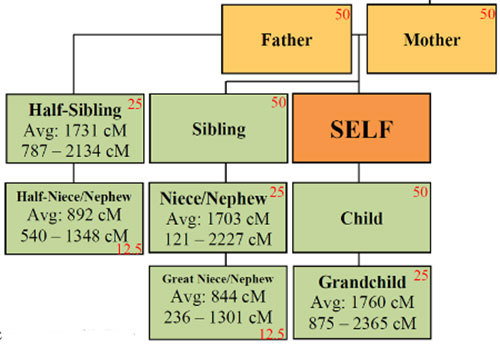
This image uses centimorgans or cM to talk about shared DNA. In this chart, 25% shared DNA is the same as about 1700 cM.
As you can see, the average is 1731 cM for half siblings which is really close to the 1700 cM we might expect. But as you can see, the range is much wider.
The range goes from 787-2134 cM! This is a range from about the level you might expect with a first cousin (12.5%) up to about 32%.
So the bottom line is that while half-siblings often share around 25% of their DNA, they don't have to.
Only Parents and Children Always Share an Exact Amount of DNA
So there you have it. Most everyone shares 50% of their DNA with their mom and 50% with their dad. In other words, sons and daughters are pretty much always 50% related to mom and 50% to dad. But this is where the exact percentages end.
Other kinds of relatives share on average around the same amount of DNA. So siblings share around 50% of their DNA, half-siblings around 25%, and so on.
But again keep in mind that there can be quite a range in real life! Someone who looks like a first cousin at the DNA level could indeed be your half-sibling.

Author: Dr. D. Barry Starr
Barry served as The Tech Geneticist from 2002-2018. He founded Ask-a-Geneticist, answered thousands of questions submitted by people from all around the world, and oversaw and edited all articles published during his tenure. AAG is part of the Stanford at The Tech program, which brings Stanford scientists to The Tech to answer questions for this site, as well as to run science activities with visitors at The Tech Interactive in downtown San Jose.
 Skip Navigation
Skip Navigation
